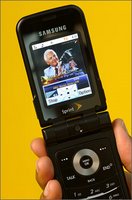 I knew parking spaces were precious. Now we have to compete with the alpha digerati to find them. Tele Atlas and SpotScout are collaborating to...
I knew parking spaces were precious. Now we have to compete with the alpha digerati to find them. Tele Atlas and SpotScout are collaborating to......help drivers find information about available parking spaces via a mobile information network. Combined with Tele Atlas’ highly accurate and up-to-date digital maps, subscribing mobile navigation system users will be able to quickly “spotscout” for and reserve a parking space that a “spotscaster” near them owns, leases or plans to vacate.
Finding the negotiated parking space should be easy, since Tele Atlas has recently announced it will be the data provider for the TomTom ONE in North America.
Q. Have you used any mobile, location-based services recently?
Friday, September 15, 2006
Real-time Digital Marketplace for Parking Spaces
Posted by
James D. McNamara, PMP
at
8:00 AM
0
comments
![]()
Labels: LBS, SpotScout, Tele Atlas, TomTom
Friday, September 01, 2006
Will consumers tune in to a tiny TV in their hand?
 Edward C. Baig, USA TODAY, reported about customers' perspectives on the phenom of TV viewed over mobile devices. It showcases MobiTV by Sprint. Although Sprint launched MobiTV in 2003, the advent of 3G speeds made it work at acceptable speeds.
Edward C. Baig, USA TODAY, reported about customers' perspectives on the phenom of TV viewed over mobile devices. It showcases MobiTV by Sprint. Although Sprint launched MobiTV in 2003, the advent of 3G speeds made it work at acceptable speeds.
IDC predicts use will grow from 7 million in 2006 to 24 million users in 2010, or 9.2% of U.S. cellular subscribers. This will drive a demand from content, especially that which can fit into small timeslices on equally small screens. As we've seen with YouTube and its look-alikes, no doubt a lot of this content will be home-brewed. Vodcast overtakes podcast.
I particularly enjoyed Stephen Froehlich's, IMS Research, breakdown of viewers into three categories:
"Snackers" spend three to five minutes watching stand-up comedy clips, sports highlights and so on. "Commuters" (or lunchtime viewers) will devote 20 to 30 minutes to watch sitcoms, dramas or news. And then there are "background noise viewers," who actually use mobile TVs at home.Q. Are you a snacker, commuter, or background-noise viewer?
Photo: by Leslie Smith, Jr., USA TODAY
Posted by
James D. McNamara, PMP
at
11:00 PM
0
comments
![]()
Labels: Sprint Nextel, tv, vodcast
Friday, August 18, 2006
Tropos 5320 MetroMesh Introduces Multi-band Mesh
 Due out in October 2006, the Tropos® Networks' Tropos 5320 combines 802.11a and 802.11b/g radios with the MetroMesh OS to create mesh networks. As expected, while servicing client nodes these points can bridge with each other over the air doing away with the need of dedicated hardware uplinks. The new twist is that they can dynamically shift between 5 GHz and 2.4 GHz spectrums to accomodate local conditions and new models promised to "quickly follow" the 5320 will add "...MIMO, WiMAX, 4.9 GHz, 3G/4G cellular and other unlicensed and licensed radio technologies" to its multi-radio capability.
Due out in October 2006, the Tropos® Networks' Tropos 5320 combines 802.11a and 802.11b/g radios with the MetroMesh OS to create mesh networks. As expected, while servicing client nodes these points can bridge with each other over the air doing away with the need of dedicated hardware uplinks. The new twist is that they can dynamically shift between 5 GHz and 2.4 GHz spectrums to accomodate local conditions and new models promised to "quickly follow" the 5320 will add "...MIMO, WiMAX, 4.9 GHz, 3G/4G cellular and other unlicensed and licensed radio technologies" to its multi-radio capability.
It's easy to see how WiMAX, for example, could help tie a router into the "wireless backbone" at the fringes of a metro area, and reach the targeted market--dialup Internet users--with comfortably backward compatible 802.11b WiFi. I don't think the typical dialup Internet user in 2006 has a MIMO router at home and a 3G phone at their side. As for 4G, I don't imagine we'll see that model out much before the infrastructure for a 4G network appears!
Q. Where have you connected to a mesh network?
Photo source of Tropos 5210 router: Tropos Networks.
Posted by
James D. McNamara, PMP
at
11:00 PM
0
comments
![]()
Labels: MAN, mesh networks, Tropos Networks, WiMAX